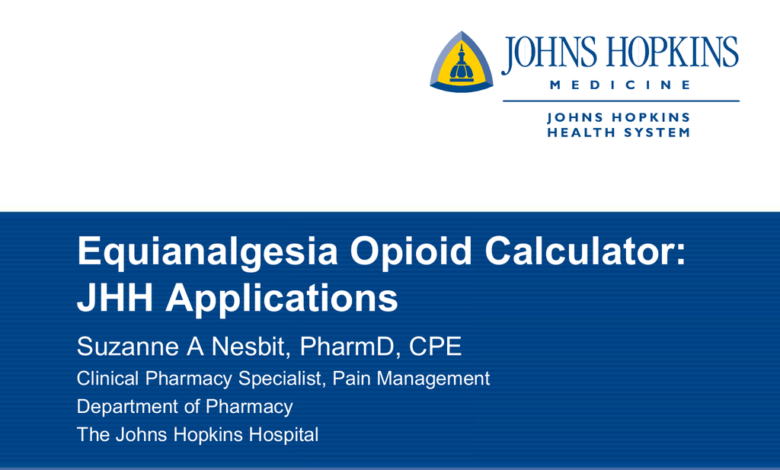Johns Hopkins Opioid Conversion Program Calculator

Opioid conversion calculations are used when switching a patient from one opioid to another, typically to manage pain. Different opioids have different potencies and characteristics, so the goal of conversion is to provide an equivalent analgesic effect while minimizing the risk of adverse effects or overdose. Here are the general steps involved in an opioid conversion calculation:
Identify Current Opioid and Dose: Determine the current opioid the patient is taking and its dose. This could be in the form of oral morphine equivalents (OME) or other appropriate units.
Determine Equianalgesic Dose: Research or consult a reliable opioid conversion table or chart that provides equianalgesic doses for different opioids. This will help you understand how much of the new opioid is equivalent to the current opioid.
Calculate Equivalent Dose: Multiply the current opioid dose by the equianalgesic conversion factor for the new opioid. This will give you an initial estimate of the new opioid dose needed to achieve an equivalent analgesic effect.
Adjust for Clinical Factors: Consider the patient’s pain intensity, tolerance, and any adverse effects they might be experiencing. Adjust the calculated dose as needed based on these factors. It’s often recommended to start with a slightly lower dose of the new opioid and titrate upwards as necessary.
Monitor and Adjust: After switching the patient to the new opioid, closely monitor their pain control and any side effects. Adjust the dose as needed to achieve optimal pain relief and minimize adverse effects.
It’s important to note that opioid conversion calculations are complex and should be performed by healthcare professionals with expertise in pain management and opioid pharmacology. There can be significant individual variability in how patients respond to different opioids, so these calculations are not always precise. Organizations like Johns Hopkins provides resources like Equianalgesia Opioid Calculator.
Clinicians have the advantage of utilizing online dose calculators to facilitate the process of opioid conversion for their patients. This calculator serves as a valuable resource for healthcare professionals who are tasked with transitioning patients from one opioid to another while ensuring optimal pain management and minimizing the risk of adverse effects.
The Johns Hopkins Opioid Conversion Program calculator, among others, offers a user-friendly and evidence-based approach to opioid conversion calculations. By inputting specific details about the patient’s current opioid regimen, dose, and pain intensity, clinicians can receive accurate equianalgesic dosing recommendations for the desired opioid switch. The tool takes into account established conversion factors, individual patient factors, and potential variability in opioid responses.
This type of online calculator streamlines the conversion process by providing a starting point for determining the appropriate dosage of the new opioid. However, it’s crucial to recognize that while these tools offer valuable guidance, they are not a substitute for clinical judgment. Healthcare providers should interpret the calculator’s recommendations in the context of the patient’s overall condition, medical history, and ongoing pain management goals.
These online calculators, particularly those supported by reputable medical institutions like Johns Hopkins, exemplify the integration of technology and medical expertise to enhance patient care. Clinicians can access such tools via the official websites of these institutions, ensuring that they are utilizing accurate and up-to-date resources for their practice.





